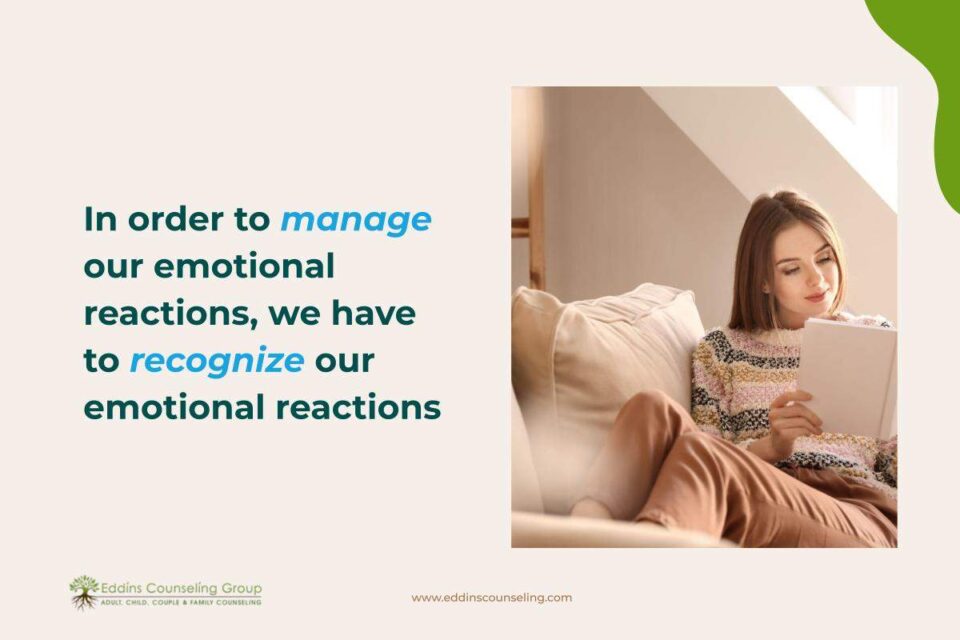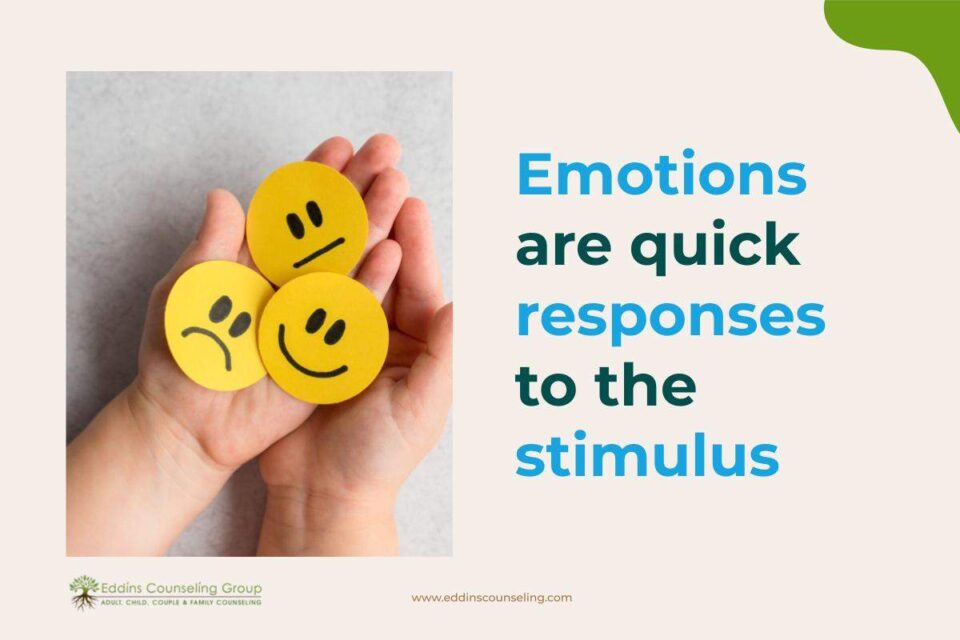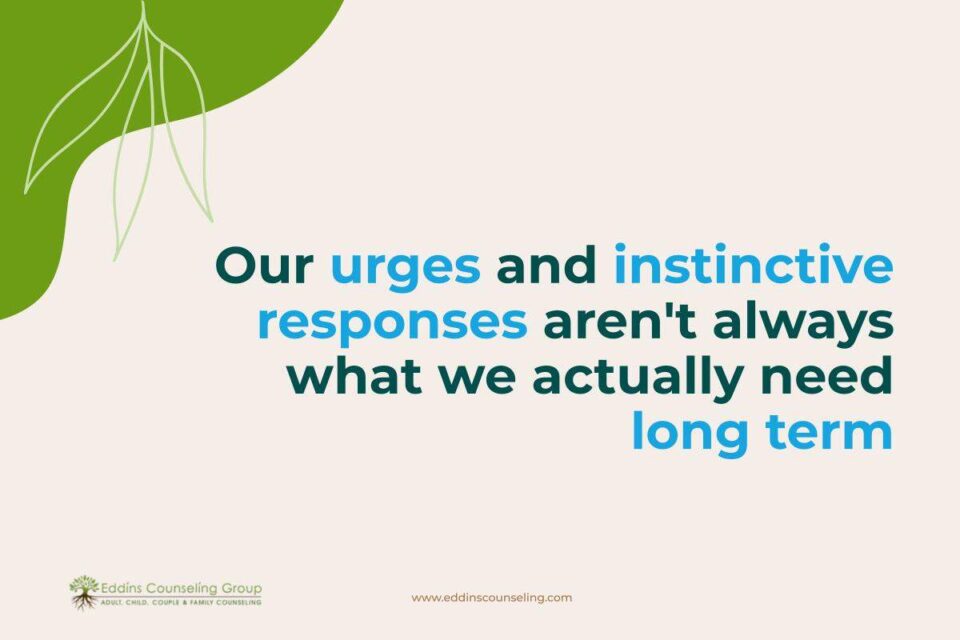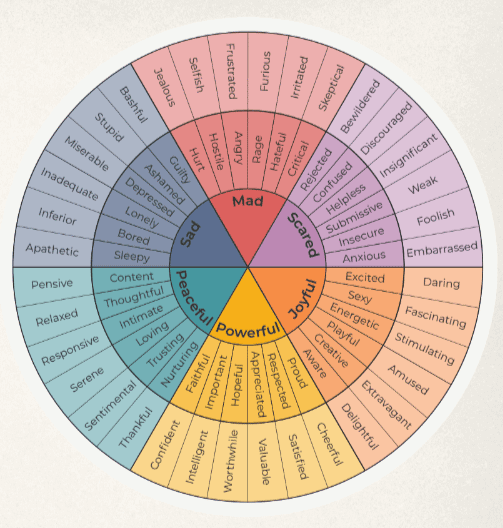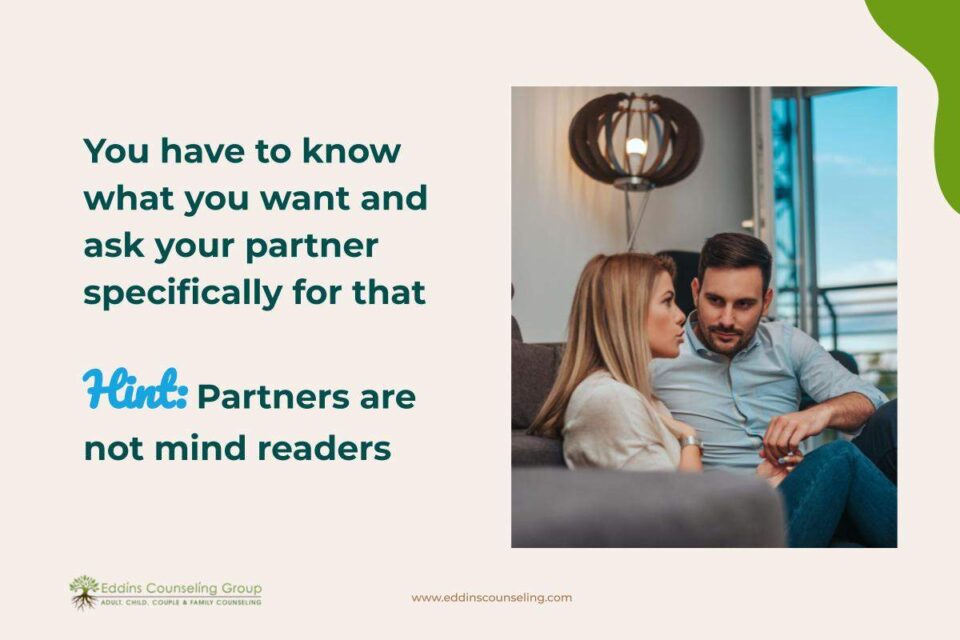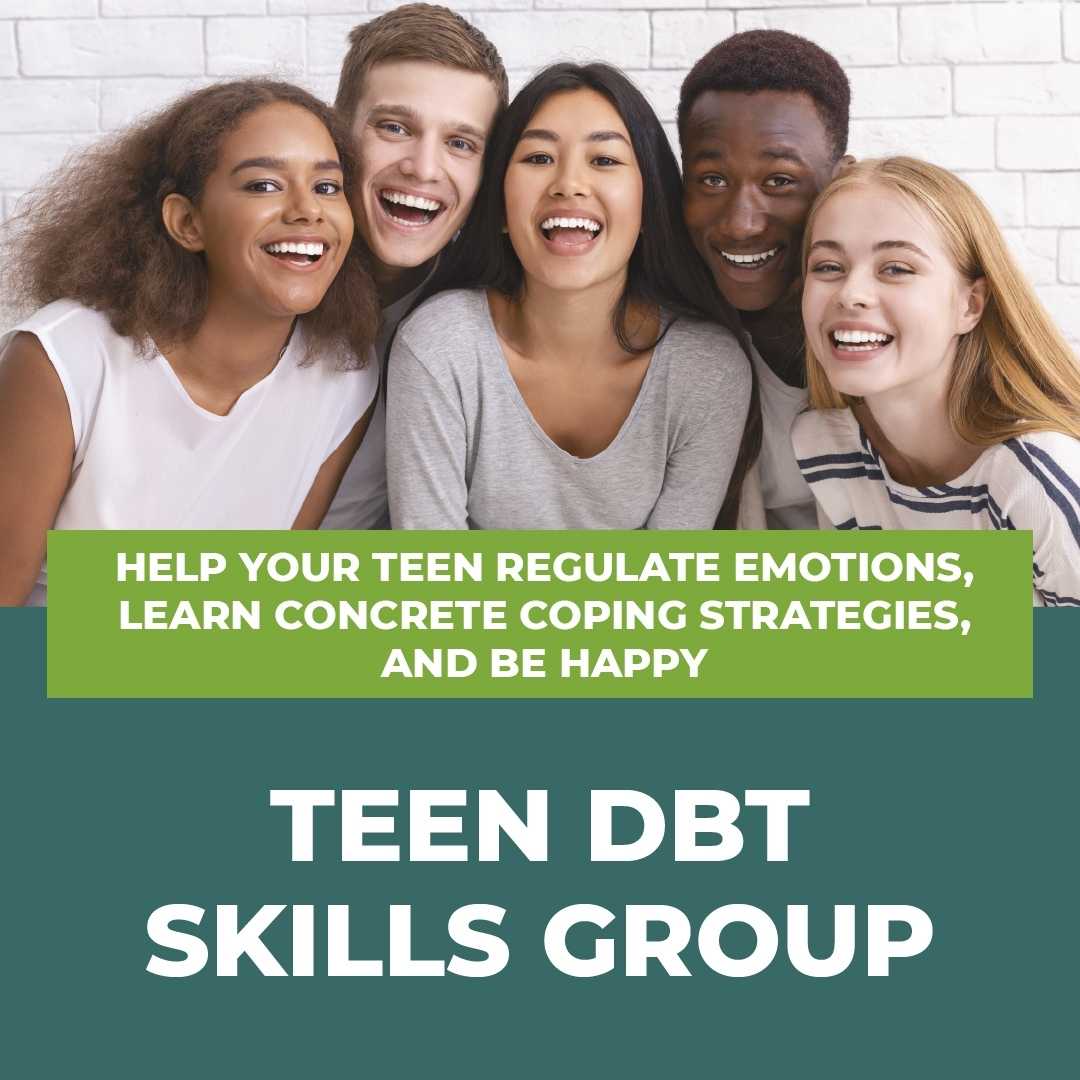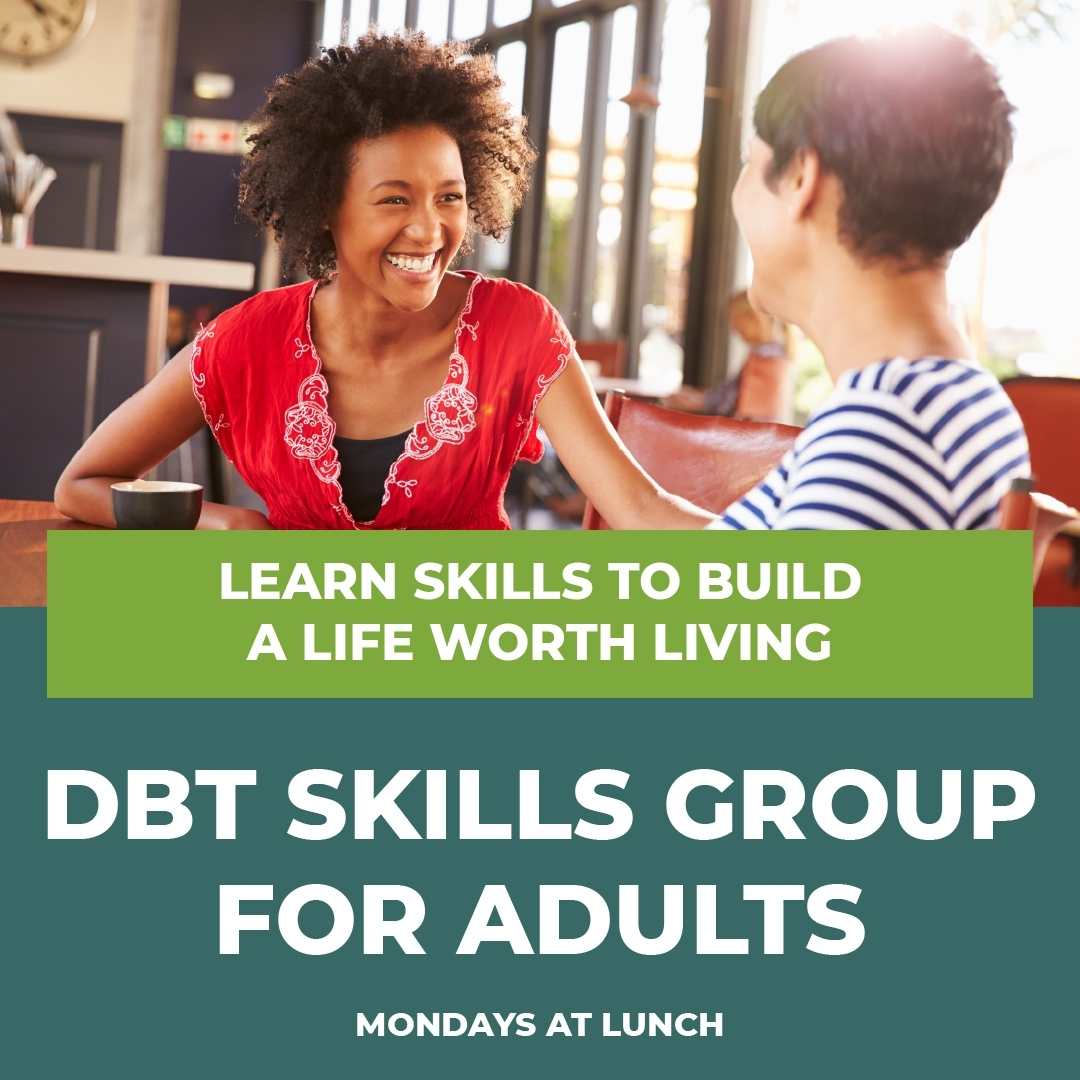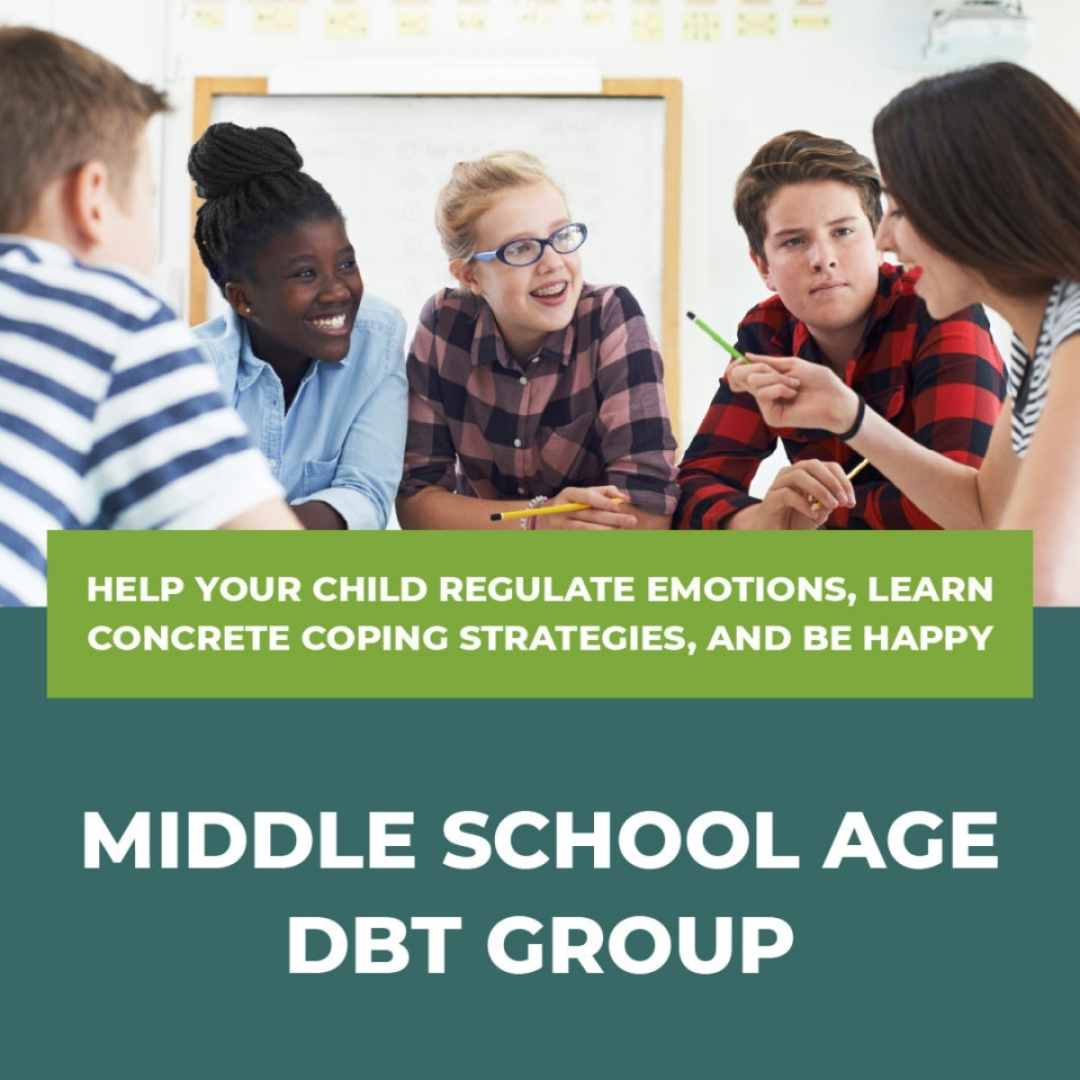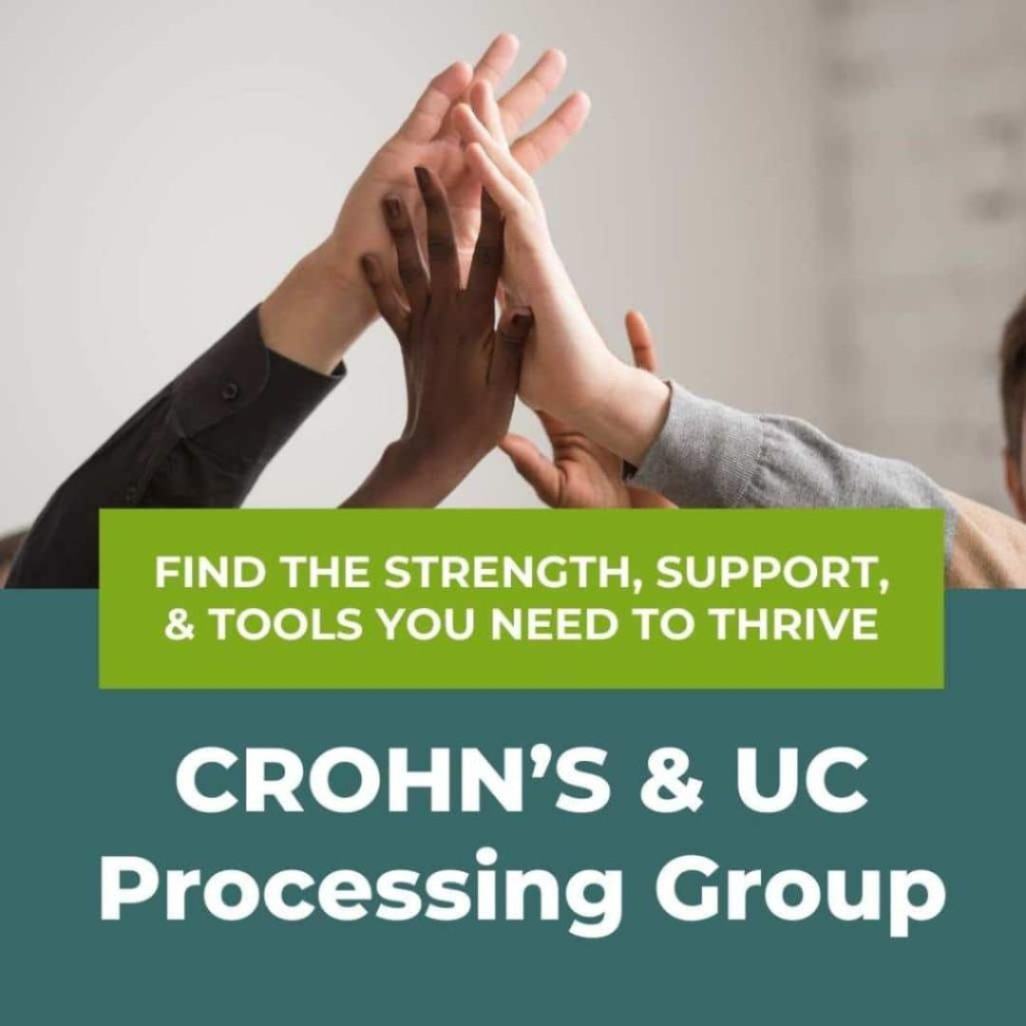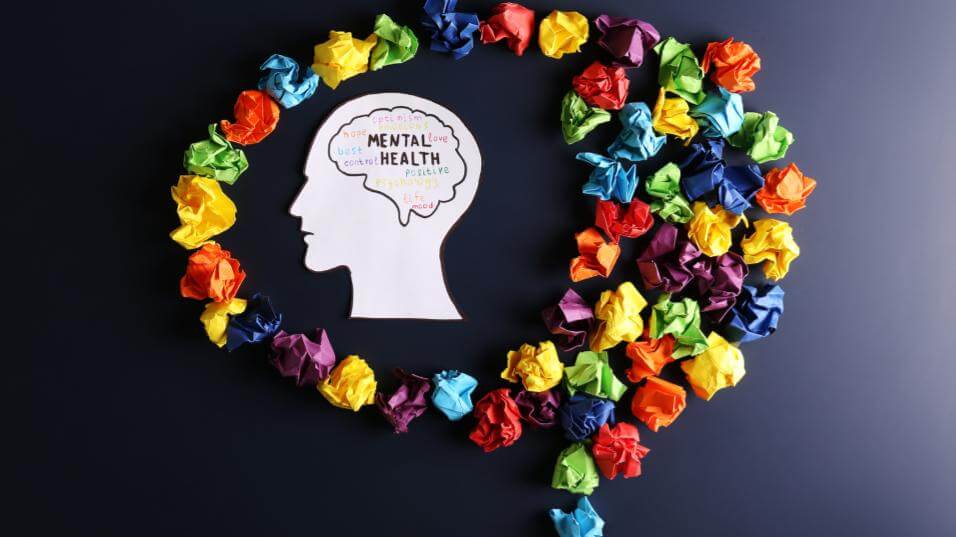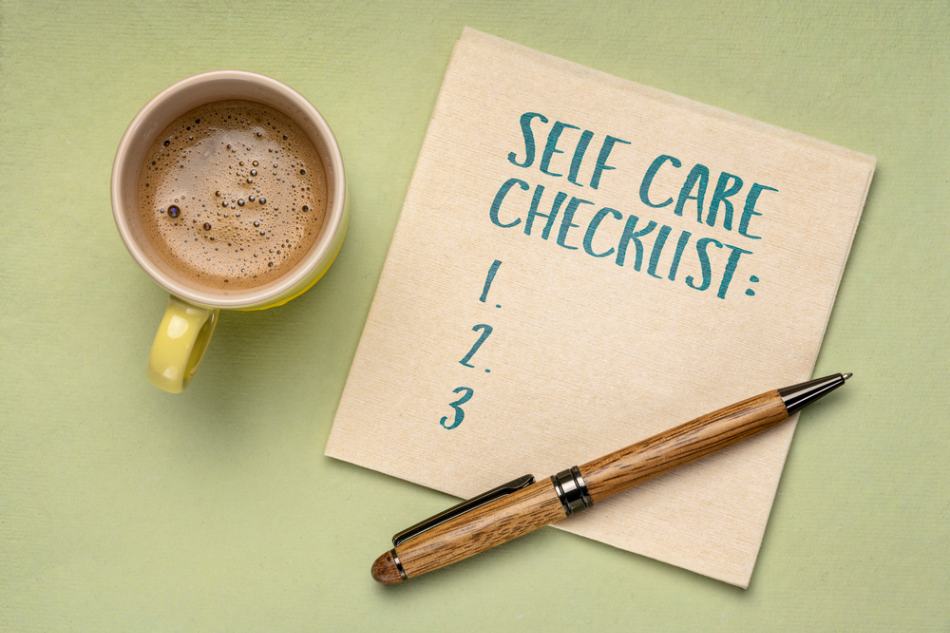September 10, 2020
Webinar: Manage Emotional Reactions to Increase Connection and Get Your Needs Met
Written by Rachel Eddins
Posted in Emotional & Mental Health, Webinars and with tags: emotional regulation

Our emotions, whether we’re aware of them or not, are at the center of our relationships and lives.
This talk will focus on understanding how our emotions drive our actions and our reactions in ways that can affect our connection to others and our ability to achieve our goals.
Mindfulness of our emotions and their link to our behaviors allows us to choose how best to get our needs met and how to react in effective ways when our emotions are highest and feel most overwhelming and urgent.
Facilitated by Alexandra Marshall, MEd, LPC.
Watch a replay of the presentation here.
Learn more about our relationship counseling services.
Here is a transcript of the webinar:
Hello! This is our Wellness Webinar: Managing Emotional Reactions to Increased Connection and Get Your Needs Met. It really just means slowing down a little bit and recognizing our emotional reactions.
Once we can recognize our emotional reactions, use the knowledge of that emotional reactions to:
- ask others to support us,
- to meet our needs, and
- to let them know what it is that we need in order to get our emotional needs met.
I think a lot of times people kind of feel confused about how to meet our emotional needs because they know how to meet their own, but they don’t necessarily know how to read ours.
We have to help them out to get those emotional needs met.
My name is Alexandra Marshall. I’m a licensed professional counselor. Before I was a counselor, I was a lawyer and I found that I encountered a lot of emotional needs that weren’t getting met when I was a lawyer.
I really wanted to understand why people react the way they do and how to react more effectively, both in my working life and in my own personal life. So that’s kind of what drew me to counseling.
Some of the skills we’re going to talk about here tonight, I use a lot in my own life. I will try to keep it interesting by using stories from my own life to illustrate some of the things that we’re talking about because I think that that kind of makes it more practical for everybody to understand.
Agenda
- Recognizing emotional reactions
- Slowing down our responses to emotional cues
- Identifying what we actually need in emotional situations
- Making effective decisions about how to respond to our emotions
- Asking others to support or respect our emotional needs
- Questions – please submit them in the chat!
Recognizing Emotional Reactions
Let’s get started. So, as I said, we’re going to talk a lot about managing our emotional reactions. In order to manage our emotional reactions, we have to recognize our emotional reactions.
We have to give them names and we have to recognize that just because we have an emotion and that emotion urges us to act in a certain way, it doesn’t mean that we actually have to act on that emotion.
So recognizing and naming the emotion can give us a little bit of distance from the emotion. It makes us more of an observer than an experiencer of the emotion.
That’s a place that we want to get to because our emotions can be overwhelming. They can swamp all reason and they can take over.
Slowing Down Our Responses To Emotional Cues
It’s really useful to slow down a little bit, get a little space between you and your emotion, put a name to that emotion, and then recognize that you have a choice about how to respond to that emotional reactions.
I find that sometimes just saying the emotion out loud, like for example, “I’m feeling anxious, I’m feeling scared, I’m feeling sad”, can act almost as a soothing tool.
It gives me kind of a break from experiencing the emotion, takes me out of the overwhelming physical experience of the emotion, and lets me look at how I’m feeling and make a decision about how to react.
We want to slow down our responses to emotional cues.
Emotions are sort of quick responses to the stimulus. That stimulus can come in the form of other people, situations, things that we see on television, things that we hear on the radio, things that people say to us, or things that we get in the mail.
There are a lot of emotional cues and they trigger an emotional response.
What we want to do is not stop experiencing emotions.
We want to just create a small gap between the experience and the feeling of the emotion and our reaction to it because emotions sort of imply a response: “If I feel scared, I want to run away. If I feel angry, I want to yell.”
Those kinds of behaviors in response to emotions are a choice that we make. What I’m hoping to do is to give you a little space between the emotion itself and your response to it, to make a choice about how to respond.
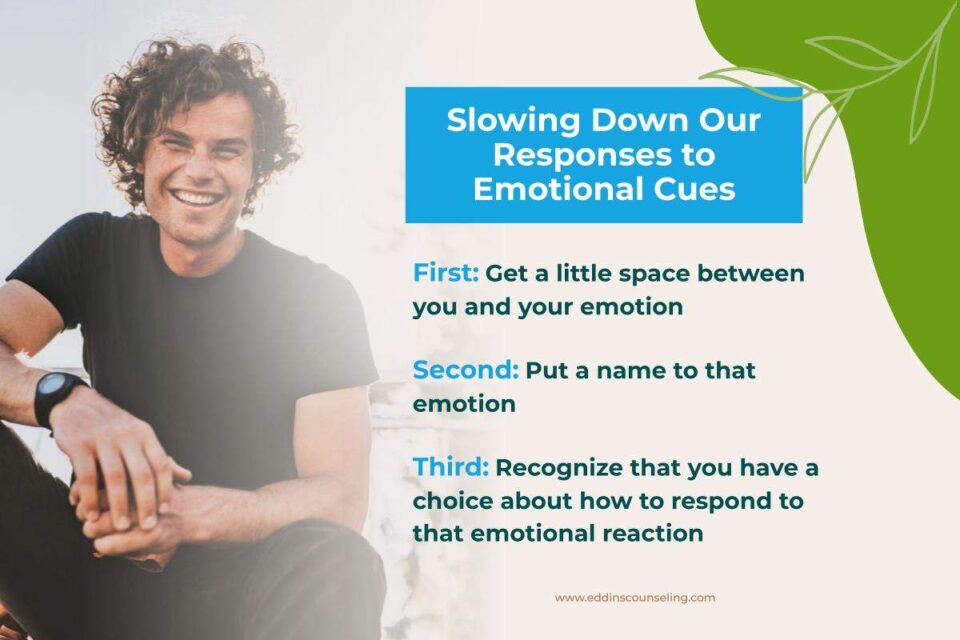
Identifying What We Actually Need in Emotional Situations
We also need to then identify what we need in an emotional situation. I think a lot of times we think we know what we need in an emotional situation because we have sort of an urge to do something or an urge to get something or an urge to cope in some way.
Those urges and those instinctive responses aren’t always what we actually need long term. They aren’t always what’s best for our relationships long term, and they aren’t always in line with the person that we want to be long term.
Here’s an example from my own life:
I live in Houston, Texas and I have road rage because the roads around here are terrible. A lot of times I would find myself in the car really angry and kind of driving aggressively.
My emotions were telling me that I needed to stand up for myself, that I needed to get somewhere on time, and that I needed to be in control of the situation.
But what I actually needed in that situation, and what I actually need any time I get in the car, is just to get to my destination safely.
So my emotions were telling me one thing, but my long-term self-interest and my safety needs were really asking for different behavior.
So I needed to slow down and think why do I get in the car?
- Do I get in the car to teach that driver who cut me off how to be a better driver?
- Or do I get in the car to get to my destination safely?
- What do I need to do to soothe that feeling of anger or that feeling of frustration to allow me to meet my long-term needs?
Identifying what we actually need in an emotional situation is really hard. It’s easy for me to put it as a bullet point of an agenda. It’s really hard to do in practice.
What it means is that we just need to slow down. We need to pay attention to what’s actually going on. And then we need to ask ourselves:
- What do I actually need in this situation?
- What are my long-term goals in this situation?
- What are my short-term goals in this situation?
- What’s most important to me in this situation?
Making Effective Decisions About How To Respond To Our Emotions
Once we know what we actually want or need in a situation, we are better able to make an effective decision about how to respond to our emotions.
Much like in my road rage example, I could respond by tailgating or cutting that other driver off or by not letting them in and the exit lane or there are a lot of ways that I could respond, but that’s not very effective.
A more effective decision is to turn up the radio, focus on driving safely, and focus on what I’m going to do when I get to my destination.
To do those kinds of things that are going to soothe the anger and get me through that situation and to my destination more effectively.
Giving in to my emotions in that situation doesn’t make me safer and it doesn’t improve my experience or my life. It doesn’t help me to get what I need. So we want to make decisions that are effective at getting what we need.
Asking Others To Support or Respect Our Emotional Needs
The last thing we’re going to talk about is asking others to support or respect our emotional needs. This is really hard because it requires us to be a little vulnerable with the people in our lives.
It requires us:
- to know what we need, and then
- be clear about what it is that we need and what it is that we’re feeling,
- what it is that we’re experiencing, and then
- be specific about asking for what we need.
My assumption really is that people want to love us, people want to meet our emotional needs, but they don’t always know how.
So we have to help them out by giving them some understanding of what our emotional needs are.
How do you do that? There are a couple of different ways that you can do that, depending on what it is that you actually want in a situation.
We’re going to talk about identifying the need and then we’re going to talk about different strategies that you can use, depending on what it is that you need out of a situation, whether it’s:
- to just get a thing done, or if it’s
- to maintain and improve the relationship, or if it’s
- to maintain your self-respect.
Those are three different kinds of needs that can arise in an emotional situation or that can take priority in an emotional situation, because obviously there are going to be situations in which both our need to maintain the relationship and our need to get a thing done are important.
We want to make sure that we are identifying what our priority is and then being effective at asking for that kind of help.
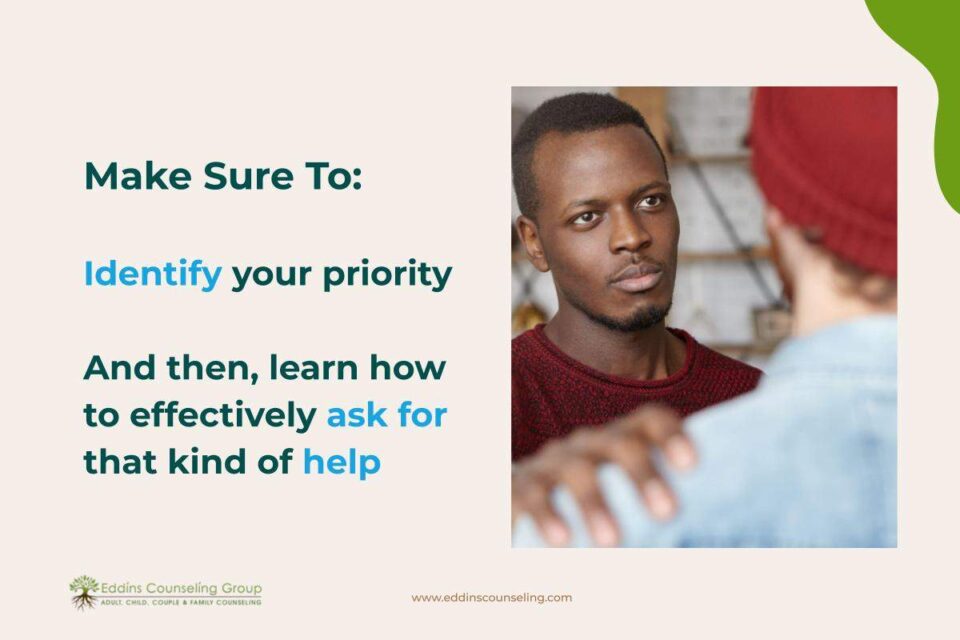
Mindfulness of Emotions
We have to start with mindfulness. A lot of times I have clients say I know what my emotions are, I know what I’m feeling. I just don’t know what to do with the feeling. But the reality is that mindfulness of our emotions is a practice.
Mindfulness is the practice of observing what is going on inside ourselves as well as outside of us, without trying to change it.
That’s kind of a confusing thing because I think we think: “I experience these emotions and I need to respond to them right away.” They feel really urgent. They feel really immediate.
And so the practice of mindfulness is getting used to observing your emotions almost from a distance without feeling like you need to grab hold of them, without feeling like you need to do something to respond to them in that exact moment that you experience them.
So it’s accepting that we’re going to have emotions and allowing them to sort of proceed as they will at that moment without responding.
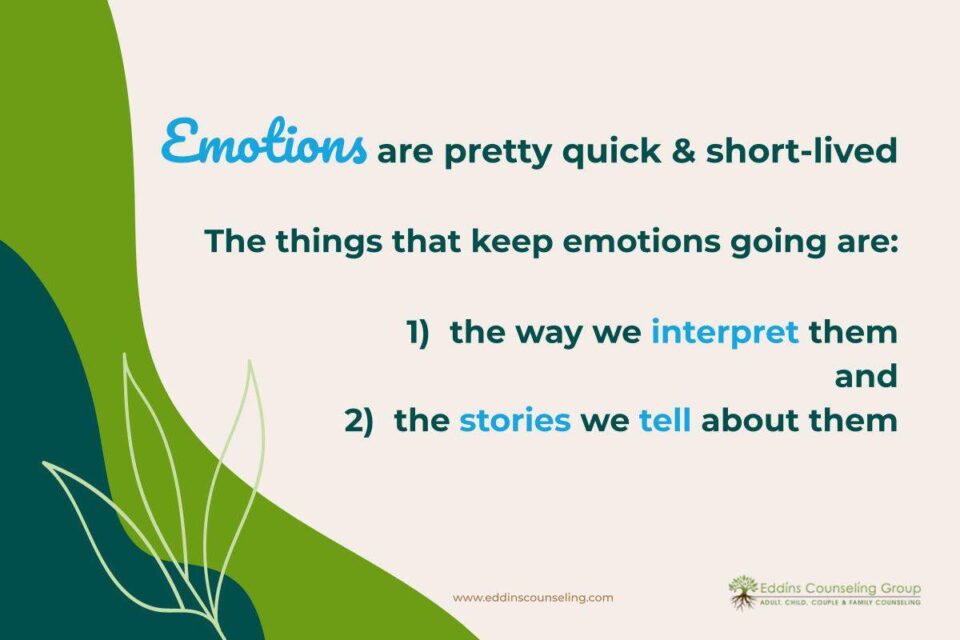
- practicing checking in with yourself and paying attention to what’s going on inside your body,
- paying attention to what you’re observing,
- paying attention to what you’re telling yourself is going on without trying to challenge your story or without trying to feel better or without trying to respond to the emotion.
- We want to practice watching what’s going on with ourselves.
I think it’s good to practice these kinds of new habits by attaching them to a habit that already exists.
For example, brushing your teeth is one that always comes to mind, because that’s a thing that we all do every day (I hope) in the morning.
Attaching a new habit like practicing mindfulness, first thing in the morning for about five minutes is a good habit to get into in a good way to build the skill of watching what’s going on. So checking in with yourself:
- How am I feeling right now?
- What is the physical sensation of brushing my teeth like?
- What are the thoughts that I’m having?
- What are the emotions that I’m experiencing?
- What am I worrying about?
The goal of mindfulness is to be present in our actual lives as they are happening. To experience reality as it is.
A lot of times we experience reality as we think it is or as we perceive it.
How we think reality is, is often covered by our past experiences, by our past relationships, by how we expect reality to be, as opposed to how it really is.
Practicing mindfulness means being sort of wholly in the moment of what you’re doing so wholly in the moment of brushing your teeth without worrying about what comes next, without worrying about what came before.
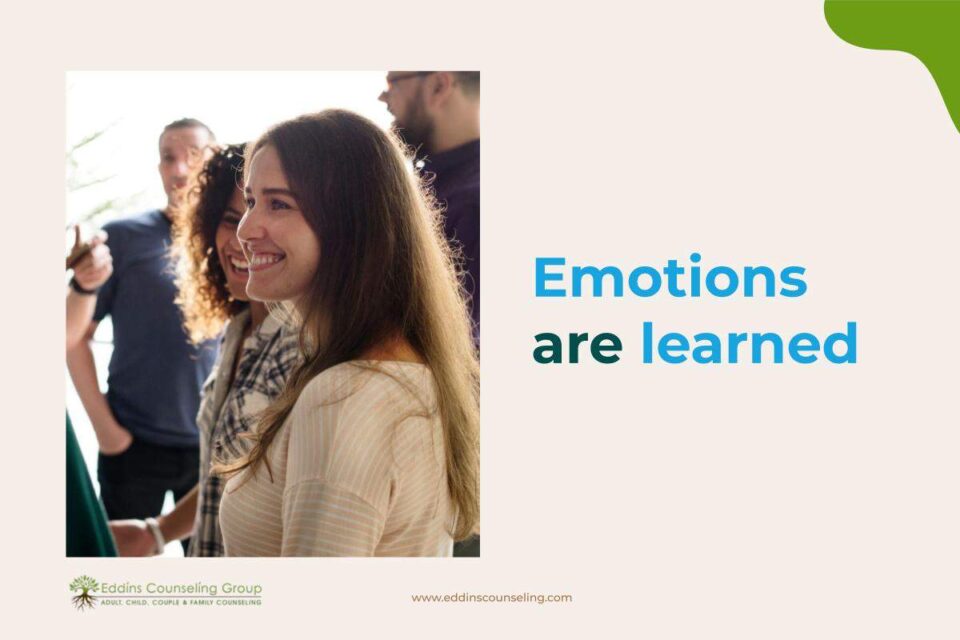
To practice mindfulness we need to:
1. Observe what is, with focused attention, using all of our senses
One of the ways that we do that is by asking ourselves:
- What am I smelling right now?
- What am I seeing right now?
- And what can I feel right now?
- What can I hear right now?
- What can I taste right now?
All of the senses give us information and I think we get used to relying on one or two of them without the kind of taking in what’s happening with the others. So we want to focus our attention on what we are actually experiencing using all of our senses at the moment.
2. Describe what we experience, without judgment – if it wasn’t observed it cannot be described
To illustrate what that means, I like to tell a story or use an example.
Let’s say we were walking down the street and I was walking one direction on one sidewalk and you were across the street walking the other direction, and you looked across the street and you saw me and you recognized me from this webinar and you thought: “Oh, I remember her” and you waved at me.
You looked at me and you waved at me and I kept walking.
Usually, clients tell me they would feel hurt, they would feel ignored, and they might get angry. They might wonder what they had done wrong.
All of those things are not actually things that they observed about me. They weren’t in the facts that I gave you about the story. All I told you was that I kept walking.
So I didn’t say that I saw you, I didn’t say that I frowned at you, I didn’t say that I recognized you, I didn’t say whether maybe I was crying, I didn’t say whether I was looking down at my phone. I didn’t say anything about what I was actually doing.
Maybe she’s mad at me, maybe she doesn’t like me, maybe I’ve done something wrong. All of those things are interpretations that you added to your mind in the past.
We want to describe only what we experience.
In that circumstance, you’d want to describe:
“I saw the woman that did my webinar. She was walking down the sidewalk across the street. I waved at her. She didn’t wave back.”
When we’re practicing mindfulness of our emotions, we want to:
- Leave out all of the judgments that we make.
- Leave out all of the stories that we apply to the situations.
- Describe what we actually experience.
- Describe what we actually see.
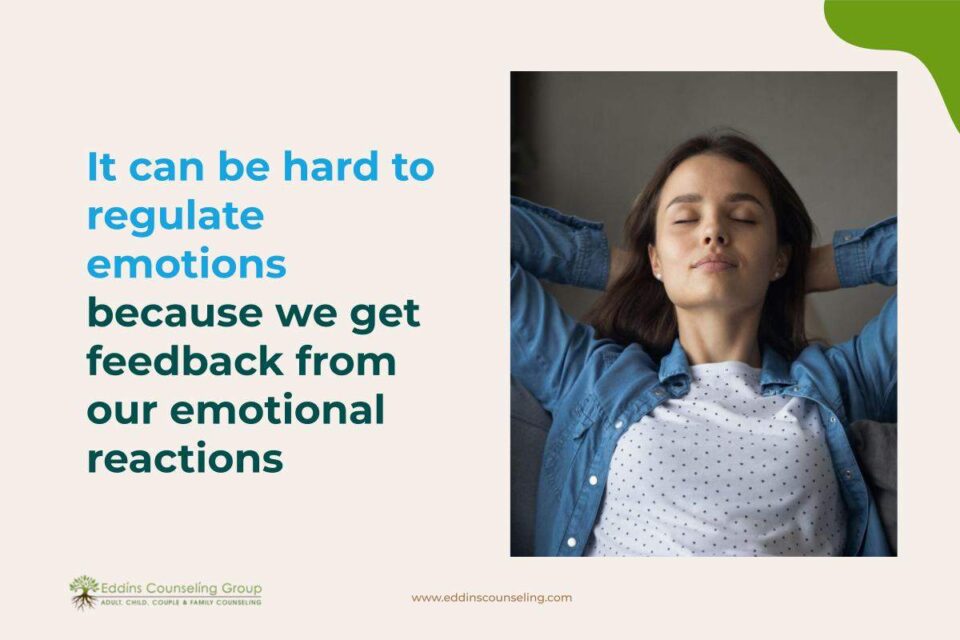
3. Participate in the present moment, without self-consciousness or judgment
What that means is that we want to be engaged with what we’re doing. This is sort of when we’re practicing mindfulness. This is the idea that you want to “dance like nobody’s watching.”
Sometimes when you are completely involved in something, you aren’t thinking about what comes next, you aren’t worried about what others are thinking of you.
You are interpreting things. You are just participating in the present moment.
I think about participating when I’m doing things that I do to take care of myself. When I’m doing things that I do to help myself, to feel good. Things like taking a walk and things like taking a hot bath or eating dinner.
We want to do these things without judging ourselves for a moment and participating in it. We want to let go of our assumptions about what’s happening.
If we are going to assume something and this is just from my own experience, we want to assume that everyone is doing their best.
Now, this doesn’t mean everybody is doing the best that they could. This certainly doesn’t mean from an objective standard: Everybody’s doing their best.
I certainly am not from an objective standard always doing the best that I could. They are doing the best they could under the circumstances and given the skills and abilities that they have available to them at that time.
That’s something that, I offer to all of my clients because I want them to know that I think everybody’s trying. I think everybody’s trying really hard to feel better, to do better, to do the best that they can to survive and thrive.
I want us to start giving that assumption or offering that assumption to others in our lives, because it allows us to look at what they’re doing, not from a perspective of their trying to hurt me, but from a perspective of: ”I wonder why they’re doing what they’re doing. I wonder why they’re reacting this way.”
It allows us to be curious about our interactions. I think that is an important component of mindfulness, being curious about what’s going on, and being curious about ourselves and about our interactions with others.
It allows us to analyze what’s going on in our interactions, and analyze what’s going on in our relationships without feeling so overwhelmed and so swamped by our emotions.
Speaking of being swamped, I think of emotions a lot like waves they kind of role in and overwhelmed us. They crashed down on us, but then they recede pretty quickly.
Neuroscientists have estimated that the physiological response that we call an emotion actually only lasts for about 90 seconds.
Emotions are pretty quick and pretty short-lived. They don’t last forever. That said, my emotions don’t last for 90 seconds. I mean, when I am upset about something, it’s definitely for longer than 90 seconds. And I would assume that you feel that way as well.
The thing that keeps emotions going is the stories that we tell about them, the way that we interpret them, the narratives that we develop about them, and how those narratives shape how we expect other things to happen.
When we’re sitting on the beach, we start to believe that we can kind of see a pattern in the waves, that we know what’s coming next, and that we can predict what’s coming. But that’s not really actually true.
We can’t predict when the waves are coming just based on what we see from sitting on the beach. We have to know a lot more.
We’d have to know a lot more about the tides. And we’d have to know about the reef formations that are under the waves.
We just have to have a lot more knowledge than we actually have to actually predict the waves. But we start to think that we can, based on what we’re seeing and based on what we’re experiencing.
Much like the waves, we want to kind of be detectives and find out what’s going on, what’s bringing the waves, and what’s causing the waves.
I think it’s normal for humans to tell stories about what’s happening. It’s normal for people to develop narratives and expectations about how other people see them.
For example, thinking:
- “Oh, everybody always just thinks I’m such a pushover.
- Everybody always just takes advantage of me.
- Everybody always gets mad at me.
- I’m always annoying people.”
Those are things that I hear a lot from clients.
I think once we develop that narrative, there is the idea of confirmation bias, which in research means that a researcher who develops the theory will then see evidence that their theory is right in everything that they look at. They will only see the evidence of their theory is right. They won’t see any evidence that their theory is wrong. Emotions and narratives kind of work that way in our lives.
We start to believe that because this is the narrative that “I always make people mad” that is then we see evidence that we always make people mad.
So if your narrative is that you make people mad and then we experience walking down the street in the way that I told you about in the earlier story, and I don’t respond to your way, you’re more likely to see that as evidence that you’ve made me mad.
Then you go to that story of: “Well, I make people mad. She’s mad. I wonder what I did wrong.”
Now we are feeling a lot of anxiety from me not waving when we were walking down the street.

Emotions Drive Actions
Our emotions tend to drive our actions and they can be really hard to regulate. Emotions are biological or the genetics drive a lot of how we feel. They are learned.
Everybody in our lives can affect our emotional responses: our families, our friends, or our partners.
It can be hard to regulate emotions because we can lack the skills to regulate them. It can also be hard to regulate emotions because we get feedback from our emotional reactions.
So if I want my husband to do the dishes and one of the ways that I can get them to do the dishes is by screaming at him, he’s probably going to do the dishes. It’s not going to be good for our relationship long term, but it’s going to work in that situation.
The feedback that I’m getting is that this works. The feedback that I’m getting is that this is a way to get my husband to do the dishes and that it’s successful.
So I’m more likely to yell than in the future, which makes it harder to eliminate the yelling response, even if I become aware that it’s affecting my relationship.
Emotions can really drive our responses and they can be really hard to regulate.
Naming Emotions
– Initially developed by Dr. Gloria Wilcox, this version taken from The Gottman Institute, Feeling Wheel
What’s helpful is naming our emotions so here you can see the Feeling Wheel which is developed by Gottman, who works a lot with couples on managing emotional responses.
I think it’s really helpful and there are lots of different versions of it online, but basically what it does is it takes the main emotions and it puts them at the center of the wheel.
Drilling Down
Spiraling out from them are different kinds of underlying emotions, so it lets us kind of drill down to what actually we’re experiencing.
A lot of times it’s really easy to say mad, but what kind of mad am I?
- Am I hostile?
- Am I hateful?
- Am I critical?
What kind of mad am I? Even within that, what’s driving it?
For example, jealousy is listed under mad, but it’s really kind of a different emotion and it implies different needs.
So drilling down within the emotions to figure out what it is that we’re actually feeling is really helpful because it lets us identify what the emotion actually is and what the need actually is.
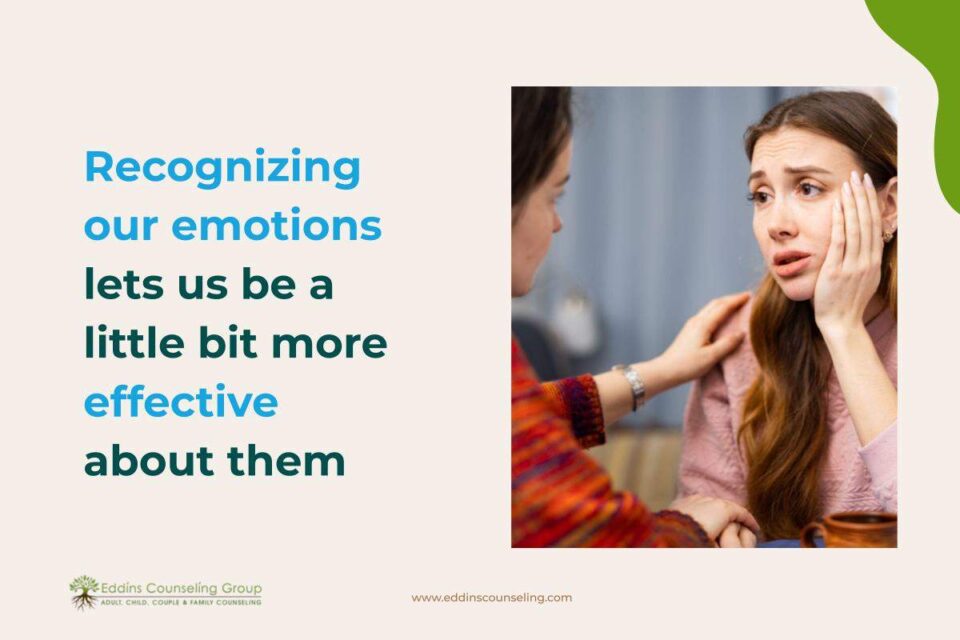
No Such Thing as a “Bad” Emotion
There really is no such thing as a bad emotion. All emotions are useful in some way. All emotions get us ready for action. So anxiety, for example, while it’s uncomfortable, is useful.
Our anxious response, our physical response to anxiety was developed thousands of years ago when we lived in caves. The thing we were anxious about was, something like a tiger coming to eat us so. In that case, if a tiger was really coming to eat us, our physical response to anxiety is useful because it gets us ready to run away.
- Your heart beats faster.
- It’s pumping more blood to your muscles,
- Your breath gets short,
- You’re taking in oxygen, and you run to store it up in your muscles, so you’re ready to run.
- You get tunnel vision and you don’t really need to look around to run. You just need to look ahead of yourself.
It’s hard to think clearly because you don’t need your brain to run away. You need your muscles. That’s a physical response. Thinking about it really slows down response.
Anxiety is useful in that situation, but it’s not always useful in the situations that we find ourselves in now. Anxiety is not a bad emotion. It’s good to be aware of when you’re anxious, but it’s not always effective to act on it.
Primary and Secondary Emotions
The other thing I want to point out is that a lot of emotions are response emotions. So we will have a primary emotion and then a secondary emotion.
I think of anger as almost all being a secondary emotion. It’s a response emotion that we go to in response to an emotion that we’re experiencing. Anger often follows hurt, sadness, loneliness, or jealousy.
- We go to anger because it feels powerful.
- We go to anger because it feels like a way of managing our reactions.
We want to always drill down underneath some of these emotions to figure out what’s actually going on.
A lot of times I use anger as sort of a sign that I need to figure out what’s going on underneath it. I use anger as a sign that I need to kind of think a little bit about what’s going on underneath the other person as well as if I’m in a safe place to deal with it.
Recognition Leads To Effectiveness
Recognizing our emotions lets us be a little bit more effective about them.
If I think: “Well, I’m just sad”, it doesn’t give me a lot of ways to attack it, but if I think “I’m lonely”, then I’m given sort of ideas about how to approach that. I’m given ideas about where to go next.
If I’m lonely, I can reach out to someone, I can call a friend, or I can arrange to meet up with someone at better times, or I can write a letter or an email.
Recognizing the emotion and drilling down to what the specific emotion is gives us avenues to approach those emotions.
Are interpretations the same as making assumptions? Does curiosity lead to empathy?
Curiosity can lead to empathy. Curiosity is the attempt to understand where someone is coming from.
Curiosity is wondering about what’s happening and wondering about what’s happening for somebody else, and that allows us to kind of imagine what led to that feeling and what caused that reaction and then to deal with what’s actually happening.
Interpretations are a lot like making assumptions. Interpretations are our own set of assumptions. They’re our own narrative about what’s happening in a situation.
They’re formed based on our past experiences, and our past relationships and they are sort of the feedback that we’ve always gotten.
Can you explain the relationship of the outer circle of the Feeling Wheel?
The Outer Circle relates to the inner circle in that it’s drilled down. The outer circle of the feelings is sort of a little lighter. They’re the ones that we kind of recognize and kind of accumulate into the bigger fields.
They also are often hard for us to recognize initially. I think a lot of people are well-versed in saying “I’m scared or I’m mad or I’m happy”.
I haven’t heard a lot of people say “I’m powerful.” But, you know, we recognize the big emotion. What we want to do is peel back the layers to what’s really going on.
We’ll look at being taken advantage of and am I mad for being hateful because I feel like the hatred for this person because our relationship has been so bad? So am I more inclined to that or am I feeling irritable? Those are shades of mad.
How do the words correlate to each other on the emotions drive actions wheel?
The words correlate in that the ones at the center are the big emotions. They’re the ones that are the most obvious emotions:
- mad,
- sad,
- scared,
- joyful,
- powerful, and
- peaceful.
Those are emotions that most of us kind of think: “Yeah, I recognize that and I can identify that. When I feel that I know what’s happening.”
The ones on the outside of the wheel are smaller. They’re more discreet and they’re often more accurate, because lonely is different than ashamed, a lot like sad.
They both feel similar and they both are similar physical experiences.
Slowing Down
STOP Sign

When we get kind of activated, use our emotional reactions as a stop sign. So when you’re driving a car and you come to a stop sign, you need to stop and look around and then continue on. We want to put up a stop sign.
When we get strong emotions, we want to think of them like that wave that’s peaking and sort of circle on the top of it for long enough that we can make a decision that’s not just a result of “in the moment” of emotion. Makes a decision that takes into account our longer-term goals and needs.
Tolerating Being Uncomfortable
One of the ways that we need to do that is by tolerating being uncomfortable. When we are highly emotional, really sad, angry, or hurt, it’s really uncomfortable. It doesn’t feel good. Nobody likes being angry. Nobody likes being sad. It’s uncomfortable.
It feels like we want to make it better as quickly as we can. So we have to tolerate a little bit of being uncomfortable in order to be effective long-term.
Self-Soothing
One of the things that we’re going to talk about is techniques to self-soothe. The techniques to calm down when we’re emotionally overwhelmed.
Acting One-Mindfully
Then we’re going to talk about acting mindfully, which means paying attention to both what our emotions are telling us to do and what our rational mind is telling us to do. We want to listen to both and find kind of a balance between the two. We want to find a middle ground between what our emotions are saying and what our rational mind is telling us.
That’s not to say that our emotions in our rational minds are always in conflict. They aren’t, but they’re looking at different things. They have different criteria in mind.
The Stop Sign
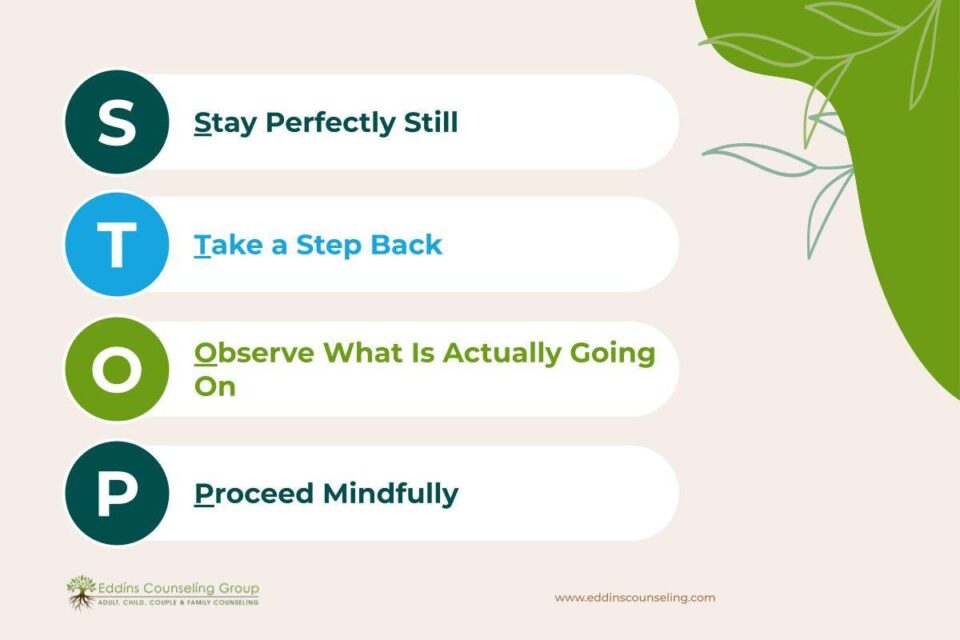
Stay Perfectly Still
The first step when we come to a stop sign is to stay perfectly still. You have to stop the car at the stop sign. You have to come to a complete stop. I’m talking about a complete stop, so stay perfectly still.
A stop sign is really useful, especially with regard to anger.
When you’re feeling really angry and you want to yell at somebody that is when you should really use the stop sign.
Because yelling at somebody leads to secondary emotional reactions, which is we feel embarrassed at the end, we feel not effective at the end, and we often don’t feel closer to them.
When we get really activated, we come to a complete stop. And in a moment, in an interaction with somebody where we’re angry or when we’re mad, you want to just stand really still, hold your body really still. Don’t move your hands, don’t move a muscle.
Take a Step Back
Then you want to take a step back. This can be an actual step back. So if you’re really angry or you’re thinking about getting in a fight with somebody (let’s say you’re in a fight with your significant other or with one of your kids).
First, you want to stop and not move a muscle, and then you want to take a physical step back. That physical step back does two things:
- It deescalates the situation that you’re in with the other person,
- It tells your brain: “Ok, we are stepping back, we’re not stepping in, we’re not leaning into this conflict, we are taking a step back and we are taking a break.
If it triggers that sensation in the brain, it triggers that retreat sensation in the brain.

Observe What Is Actually Going On
The next is to observe what’s actually going on. We want to see if what we’re telling ourselves is what we’re feeling actually what’s actually happening.
“Is that person across the street really not waving back at me because they’re angry? Or am I going to observe something that might make that not true?”
We want to observe what’s actually going on. And also by observing, that means checking in with ourselves:
- Is what I’m feeling really anger or is that something else?
- Am I feeling abandoned or am I feeling hurt?
- Am I feeling taken advantage of?
- What’s actually going on in this situation?
- What am I actually feeling?
- And what do I actually need?
You want to ask yourself whether the intensity of the emotion that you’re feeling fits the circumstances.
- Do I need to be this mad? For example, my husband didn’t do the dishes.
- Do I need to scream at him or do I need to just talk to him about it?
- Does the intensity of what I’m feeling fit what’s going on?
It might be that it does or it might be that it doesn’t. We want to just ask ourselves, be a detective about this.
Proceed Mindfully
The last one is to proceed mindfully. At a stop sign after you looked around, you could continue on your journey.
So you can choose to continue yelling or you can choose to do something different like say: “I need to take a break. I’m feeling hurt. I’m feeling abandoned to kind of address the actual emotion that’s going on underneath.”
The stop sign isn’t designed to stop the interaction. The stop sign is designed to de-escalate the interaction. It’s designed to choose what’s most effective in that situation.
Managing Discomfort
- Controlled breathing
- Intense exercise
- Dive reflex
- Distraction
- Soothing support
- Saying “No!” to crisis urges
- Willingness
Once we’ve stopped, we’ve looked around and we want to proceed, we’re still feeling an emotion and it’s really uncomfortable, so we want to do things that are going to help to bring down the intensity of our emotional reactions.
These are some ideas that you can use, and they are of varying utility and varying circumstances.
Controlled Breathing
The first one is, I think, the most useful called controlled breathing. But what it really is, is breathing in through your nose and out of your first lips.
It’s kind of like yoga breathing.
Focus on breathing out for longer than you breathe in.
So it’s a normal breath into the nose and then a slow and controlled breath out.
You want to imagine you’re blowing a feather across the surface of a lake or blowing out birthday candles, but there are a lot of them, so you need to do a sweep. It’s a slow and controlled breath out.
Our somatic nervous system, which is the nervous system that controls our fight or flight response, is activated when we’re in a really high emotional response.
When we’re in a really high emotional moment, that somatic nervous system is firing and it can feel like we’re kind of overwhelmed.
Breathing out is an off-switch for that nervous system. It tells the body that it’s time to stop, that it’s time to rest and relax.
If you breathe out for longer then you breathe in, you’re giving your body more off signal than on.
On is breathing in. Off his breathing out. Breathing out for longer gives you more off, and it helps to kind of calm you down. That’s one that I like to practice and I use it a lot.
- I use it if I’m in the car and I’m feeling that road rage.
- I use it if I’m in a fight with my husband or with my kids.
- I use it when I’m feeling overwhelmed.
- I use it when my Internet connection is really bad.
It’s useful to kind of turn off your physical response and to help your body to calm down and help you feel in control of your reaction.
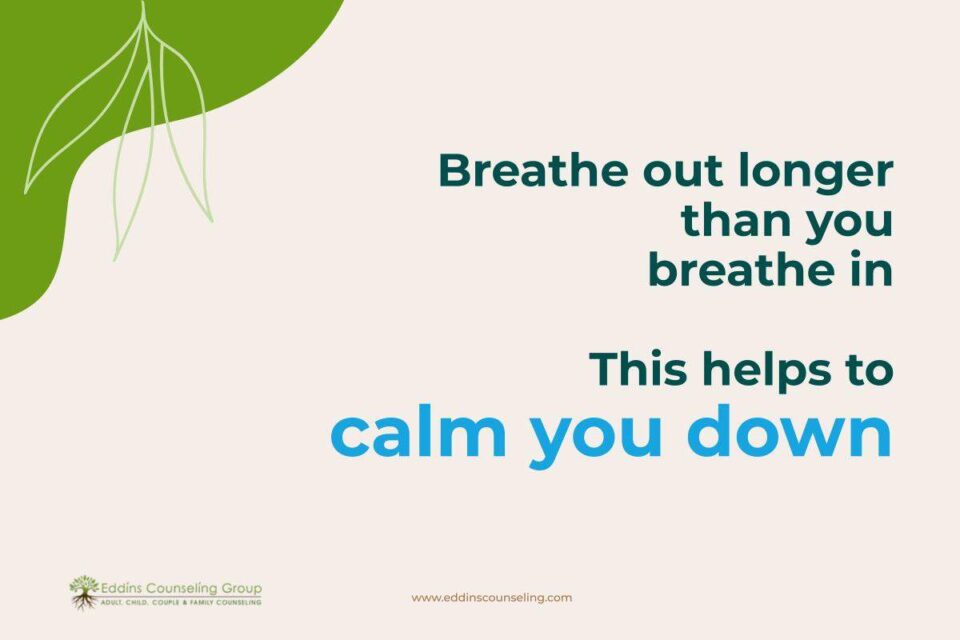
Intense Exercise
The other alternative is intense exercise. I mean, like sprinting up and down the stairs twice, running up and down the block, 10 pushups, 10 jumping jacks, something like that.
Now, you can’t always do this. This is not always an option for everybody, but it does work to kind of power out some of that emotion and then you can kind of come back to dealing with what’s actually going on.
Dive Reflex
The next one is the dive reflex. For this, you want to put an ice pack over your eyes, touching both your top eyebrows and the tops of your cheeks. And you want to hold your breath for as long as you can, maybe 30 seconds if you can. It helps to trick your body into thinking it’s diving into cold water.
Our bodies are kind of remarkable in that they think when they go into cold water that they need to conserve energy, that they need to slow down. Engaging the dive reflex:
- slows down your response,
- slows down your heart rate,
- slows down your breathing, and
- helps you to feel a little bit more in control.
It’s one to practice. It’s one to try. And it’s pretty easy to do. I mean, it’s not something you can carry around to do at work, but it does actually work in kind of a soothing way.
Distraction
Watching TV, reading a book, or playing a game on your phone. I know a lot of people play Candy Crush or those kinds of games, and those are a good distraction.
We can’t live in distraction. But when you’re really uncomfortable and really emotional, just distract yourself for long enough so that you kind of surf over the worst part of the wave and are able to kind of get to a place where you can be effective at dealing with what’s coming up for you.
Soothing Support
Soothing support means asking somebody for some soothing, asking for a hug, asking for somebody to sit next to you, and asking for something that would help you to feel better.
If you have a dog, sometimes hugging your dog, and getting these kinds of soothing supports when you’re really activated can be helpful and help us to slow down.
Saying “No!” to Crisis Urges
That’s where it feels really urgent that you do something, where you feel like you have to do something, even though you know it’s not what you want to do.
Sometimes just saying “No” out loud helps to kind of stop you, helps to kind of break you out of that urge and break you out of that cycle.
Willingness
The last is willingness, which includes:
- being willing to be uncomfortable,
- being willing to be in the moment, and
- being willing to experience our emotions.
It’s really hard, but it also kind of helps us to manage our emotions. It’s an acceptance that we are going to get upset, that we are going to be angry, that we are going to be uncomfortable.
And it’s knowing that that emotion won’t last forever.
So those are kind of some tools that you can use to manage discomfort.
Acting “One-Mindfully”
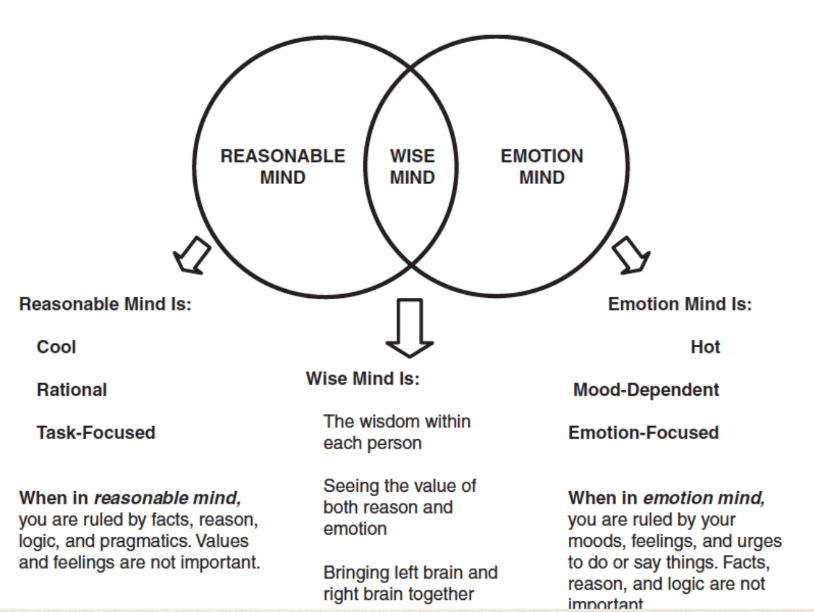
– Marsha Linehan, DBT Skills Workbook
We want to find a place of balance between our reasonable mind and our emotional mind.
I think of these as being in a state of the Wise Mind.
Now, I didn’t come up with this. This came from Marshall Linehan’s book, which is a DBT Skills Workbook.
Basically, DBT is a mode of therapy that uses all of these tools to manage your emotions. So that’s where a lot of these ideas come from.
We want to balance that hot emotional mind and our reasonable mind, which is kind of more cool and logical and come to a place that allows both of them to feel heard, that accommodates the needs of each.
I think of this also as being right-handed or left-handed. One or the other is probably more where you live.
You might feel like everything comes from your emotional mind and you never really listen to that rational, reasonable mind. You’re not used to focusing on that mind.
Or you might feel like a reasonable mind feels really safe and that emotional mind over here is scary: “I don’t want to focus on that. I don’t want to be ruled by my moods”.
The idea is to find a place of ballots to hear what our emotions are telling us, but also to apply reason and logic.
To look at the facts and whether or not those emotions that are talking to us are telling us something that is true and finding ways to accommodate both. We want to balance them. We don’t want to ignore one because it’s information and it’s useful in a group.
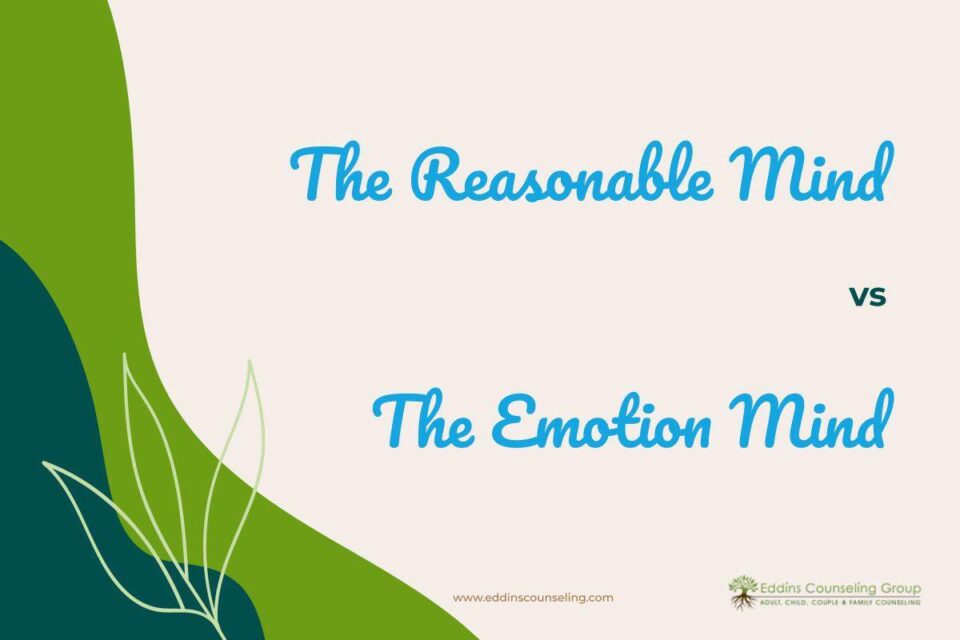
I tend to do this with an example of picking a spouse. The reasonable mind is going to identify the things that we can evaluate, such as:
- making a certain amount of money,
- having a similar job to mine,
- having brothers and sisters, and
- wanting kids, etc.
Those are the reasonable mind criteria.
The emotional mind criteria are:
- feels funny,
- feels safe,
- loves me,
- understands me, etc.
You can pick from the emotional mind side, but if you pick a spouse from only the emotion mind side, you might get a spouse who doesn’t want kids, never has a job, isn’t willing to contribute, doesn’t really care about money, when you want a house, and is happy to just play their guitar on the couch. That might be fine with you, but it might not be fine with you.
And if you ignore the reasonable mind in picking a spouse, you’re going to end up with somebody that maybe satisfies all these emotional things, but you’re going to fight a lot because you don’t share the reasonable mind things.
If you pick from the reasonable mind side, you know, you might end up with a serial killer because you’re picking somebody who has a good job. Sure, there are your same interests and it’s 5′ 11″ or whatever. Not focusing on makes me feel safe.
We want to pick a spouse from a place that hears both sides. So that’s how I like to think about acting when mindfully.
We want to listen to both sides because both sides are providing really interesting and useful information, and then find a place that balances them.
Maybe it is not possible to satisfy all of the things that are reasonable and maybe it’s not possible to satisfy all of the things that our emotions might want. But there might be some criteria that accommodate both that allow us to really feel satisfied.
Building Supportive Relationships
Accept That Others Are Doing The Best That They Can To Love Us
The first thing is to accept that other people are doing the best that they can to love us. So here’s a story from my own relationship, because I think it’s really useful in sort of illustrating this:
When I drive home after work sometimes, I would listen to the news and I would get upset about something that I heard on the news. And I’d want to come home and I’d want to tell my husband about what I heard on the news and have him tell me that that’s terrible or whatever.
What would actually happen is I would come home and I would tell him about what I heard on the news and he would say: “Oh, no, you don’t have to worry about that. You know, that’s not going to happen or that’s not going to be a big deal because of X, Y, and Z reasons.”
And then I would get mad because I would feel like he was telling me that I didn’t understand what I was hearing on the news. Then suddenly I’m yelling at him and telling him about all of my degrees and why I understand what’s happening. And he is totally confused and we’re fighting.
What I had to kind of realize was that he wanted me to feel better. That’s what he was trying to do. That was his goal. But he didn’t know how to do that. He was making me feel better in his own way. I had to accept that he was doing the best that he could, but that he wasn’t being effective because he didn’t know what I wanted. He didn’t know what I needed. He didn’t understand what was going to make me feel better.
Realize What You Actually Need
So first I had to think about:
- “What do I actually want him to do?”
- “What do I actually need in order to feel better?”
Obviously, if I don’t need him to explain why it’s not important because that’s not making me feel better. What do I actually need? I need to feel heard. In that situation, I just wanted him to say: “You know what, you’re right. That’s terrible.”
And then I would feel better. I would feel like he heard what I was saying. I would feel like he understood what I was saying and I wouldn’t need any more than that. That’s all I really needed was just that validation. So how do you do that?
Ask Others For It
You have to ask for that and you have to ask for it specifically. I had to get in the practice of coming home and saying: “Ok, I’m going to tell you something that I heard on the news. In the end, I just want you to say you’re right, that stinks. That’s all I need. I don’t need you to explain it to me. I don’t need to discuss it. And I don’t want to get into it. I just want you to say you’re right. That stinks.”
At first, he kind of fought me on it because he was like: “Well, don’t you want me to explain to you why you don’t need to worry about it?” I said: “No, no! All I need you to say is: You’re right. That stinks.”
So then I would tell him what I heard on the radio and he would sort of start to explain and I say: “No, no, I just want you to say you’re right, that stinks.” And he would roll his eyes and say: ”You’re right, that stinks”. And I would feel better.
I would give him the response that I feel better and we don’t have to talk about it anymore. It was a negotiation.
Be Effective At Communicating What You Want The Other Person To Do
I had to figure out what I wanted and I had to ask him to give it to me. And then I had to accept when he did as being good enough.
He didn’t really want to say: “You’re right, that stinks.” He wanted to tell me why I didn’t have to worry about it, but he wanted more for me to feel better.
So I had to help him out. I have to give him the tools to help me feel better because it’s really hard to know what’s going to make somebody else feel better.
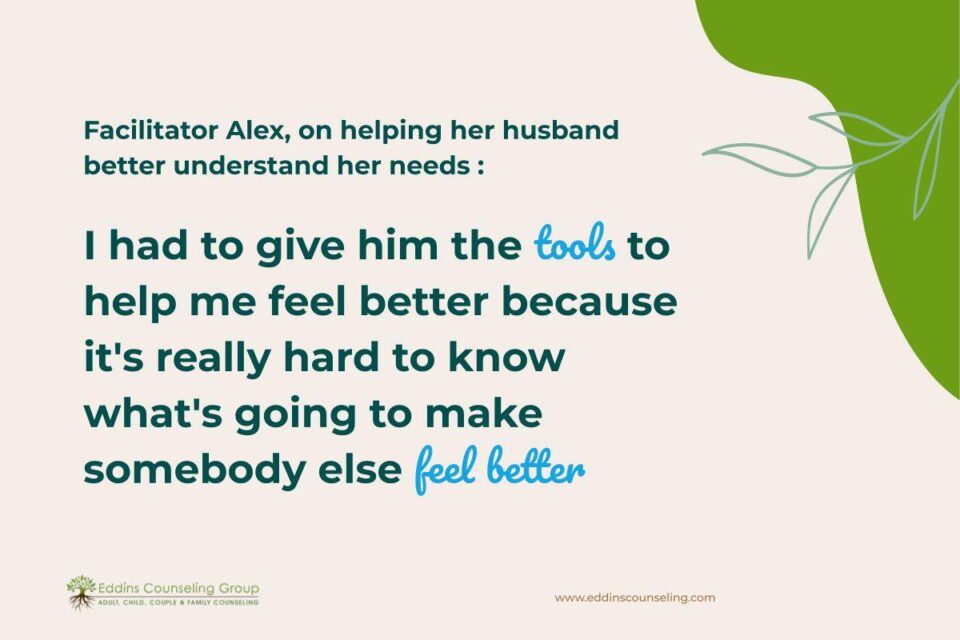
Understand Your Goals
Consider The Consequences – In Both The Short Term and Long Term
You have to understand your goals. You have to consider the consequences of reacting, the consequences of what you’re asking for, and how you’ll feel if they can’t or won’t give it to you. So this is the same for both short-term and long-term consequences.
Clarify Your Priorities:
- What you actually want – the objective;
- Keeping a positive relationship, or
- Maintaining your self-respect.
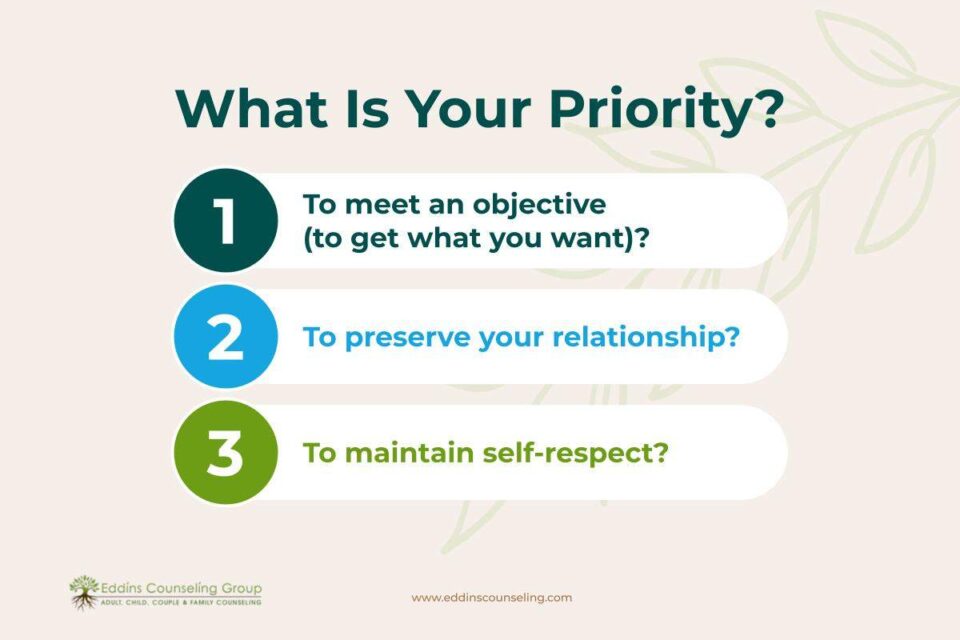
What Do You Actually Want?
The Objective?
You want to clarify your priorities. Is your priority to get what you actually want?
I think of it like when I go into the store, and I want to buy something. I don’t really care about my relationship with the clerk long term. I’m not worried about my self-respect. I just want to get something.
If I’m having a discussion with my boss and I need a raise in order to keep working there. What I actually want is a raise. That’s what’s important. I don’t care as much about the relationship with my boss long term because I’ve decided that I need the raise in order to keep working there. And I don’t care about my self-respect as much as I care about getting the raise.
Keeping a Positive Relationship?
1) So in some circumstances, like with the dishes and my husband, keeping a positive relationship is the priority. It might be that I just need to get the dishes done.
But sometimes I actually do care more about the relationship than the dishes. I hope long term most of us care more about the relationship than the dishes.
So clarifying your priorities in interactions, clarifying what you need.
Sometimes in conversations, in negotiations, or in emotional situations with other another person, the most important thing for us is to keep a positive relationship with that person.
Keeping a positive relation means “I don’t care about the thing that we’re talking about as much as I care about maintaining this relationship, maintaining positive feelings, maintaining the feeling that this person feels positively about me.”
2) The objective priority is getting what you want to be accomplished.
Maintaining Your Self-Respect?
I think the last one, maintaining your self-respect is one that we often overlook. I think it’s important.
It’s important that we leave interactions in a way that allows us to feel good, that allows us to feel like we have achieved the things that we wanted to achieve, that we have done it in a way that we feel that we can still maintain our self-respect.
Accept That You Cannot Control Other People’s Responses
The last point about understanding your goals is we have to accept that we can’t control other people’s responses. We can tell them what we need.
Like I could tell my husband: “This is what I want you to say”, but I can’t actually make him say it. That’s a choice that he has to make. He has to be willing to do that and he has to choose to do that. I have to kind of accept that I can’t always do that.
All three of those imply different approaches. If what you actually want is the thing, you can approach it in a much more assertive way. You can approach it in a much more technical way.
1) Prioritizing The Objective
- Describe the situation – stick to facts
- Express your feelings and beliefs clearly
- Ask for what you want, clearly and specifically
- Reinforce – discussions, even with loved ones, are negotiations.
If you are approaching a situation where you want to get the thing, you can describe the situation, you can express your feelings and beliefs, and then ask for what you want. That’s sort of the example of telling my husband: “This is what I want you to say”.
2) Prioritizing Relationships
- Be gentle, nice, and respectful in approach;
- Be interested (or at least act interested) in the other person – their motives, understanding, and beliefs;
- Validate that their thoughts, feelings, and actions are understandable to you (you don’t have to agree with them to understand them); and
- Be lighthearted, use humor and soothing
If your priority is to keep the relationship, you’re going to be softer. You’re going to be more willing to hear what they have to say. You’re going to be more focused on their perspective, on validating their perspective, on letting them know that you understand them even if you don’t agree with them.
3) Prioritizing (or Maintaining) Self-Respect
- Be fair to yourself and the other person;
- Do not apologize for your beliefs or needs. For disagreeing or for having an opinion;
- Stick to your values and integrity;
- Be truthful, and
- “No.” Is a complete sentence.
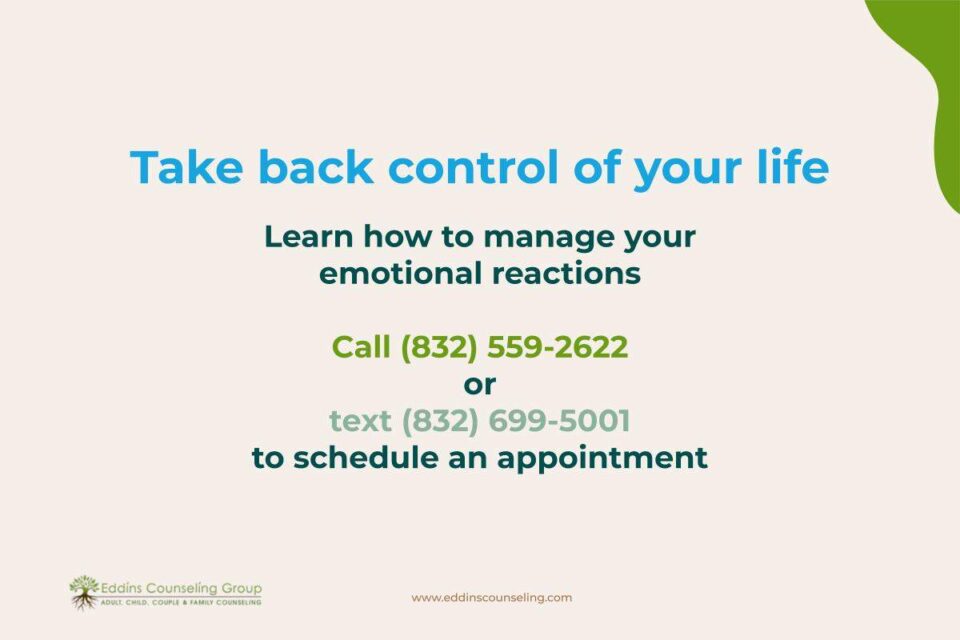
If you’re focused on maintaining your self-respect, it’s more important to be fair to yourself, to not apologize, to stick to your values, and to be truthful.
You can do these things in other circumstances, but you’re going to be softer in the relationship when you’re focused on keeping a positive relationship than if what’s really important is I want to feel like you stood up for me.
This is when we’re drawing boundaries and when we are saying “No” to something.
The most important thing that I think that you can remember when you say “No” to something is that “No” itself is a complete sentence. Saying “No” without apologizing, and without offering an explanation is important.
I appreciate you guys coming in tonight and I apologize again for the connections.
Sources used:
- Brown, B. (2012). Daring Greatly. Avery.
- Linehan, M. M. (2015). DBT Skills Training Manual, 2nd ed., The Guilford Press.
- The Feeling Wheel
- Wilcox, G. 1982. The Feeling Wheel: A Tool for Expanding Awareness of Emotions and Increasing Spontaneity and Intimacy. Transactional Analysis Journal, 12(4), 274-276.
Grounding & Self Soothing
Get instant access to your free ebook.
Why You Feel This Way
Get instant access to your free ebook.


